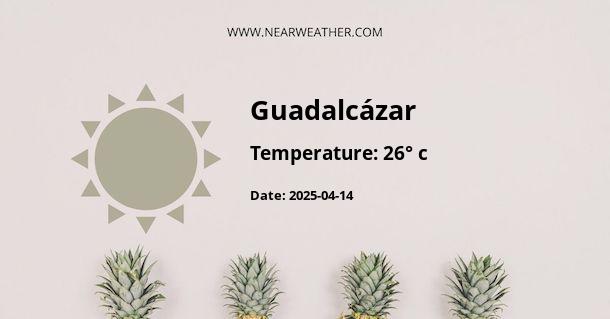Guadalcázar, Mexico: Climate and Weather Overview
Guadalcázar is a municipality located in the state of San Luis Potosí, Mexico. Its climate is an important factor that shapes the local environment and influences the lives of its residents and visitors. Understanding the weather patterns and climatic conditions of Guadalcázar is essential for anyone considering visiting or residing in this region.
Climate in Guadalcázar
Guadalcázar experiences a semi-arid climate, characterized by hot and dry conditions for most of the year. The combination of geographical location and climatic factors contributes to the unique weather patterns observed in this region.
Temperature
The temperatures in Guadalcázar can vary significantly throughout the year. Summers are hot, with average high temperatures reaching around 34°C (93°F) in the hottest months of June and July. Winters are relatively mild, with average highs of around 23°C (73°F) in the coolest months of December and January.
The temperature variation between day and night can be quite distinct, with daytime highs giving way to cooler evenings, especially during the winter months. This fluctuation in temperature is characteristic of semi-arid climates.
Rainfall
Rainfall in Guadalcázar is limited, with the majority of precipitation occurring during the summer months. The rainy season typically spans from June to September, with August being the wettest month. Annual precipitation in Guadalcázar averages around 400-500 millimeters (15.7-19.7 inches).
The limited rainfall and semi-arid conditions contribute to the arid landscape and the types of vegetation that can thrive in this region.
Wind and Humidity
Guadalcázar experiences moderately low humidity levels, particularly during the dry season. The prevailing winds in the region can contribute to the overall feel of the climate, with occasional gusts and breezes providing relief from the heat during the hottest months.
Weather Patterns Throughout the Year
Understanding the variations in weather throughout the year is important for planning activities and making the most of what Guadalcázar has to offer.
Spring (March-May)
Spring in Guadalcázar brings rising temperatures and the gradual transition from the cooler winter months to the warmer summer season. Daytime temperatures gradually increase, making it an ideal time for outdoor activities before the peak of the hot summer weather arrives.
Summer (June-August)
Summer in Guadalcázar is characterized by hot and dry conditions. Daytime temperatures can soar, and the region experiences its highest levels of precipitation during the rainy season. Visitors should be prepared for intense heat and the possibility of sudden, heavy downpours.
Autumn (September-November)
Autumn brings relief from the summer heat as temperatures gradually begin to decrease. The weather becomes milder, creating pleasant conditions for outdoor exploration and cultural activities in and around Guadalcázar.
Winter (December-February)
Winter in Guadalcázar is relatively mild, with cooler temperatures compared to the summer months. While daytime temperatures are comfortable, evenings can be cooler, making it important to pack layers for outdoor excursions and adventures during this time of year.
Conclusion
Guadalcázar's semi-arid climate defines the local environment, shaping the landscapes and influencing daily life in the region. Understanding the weather patterns and seasonal variations allows residents and visitors to make the most of what Guadalcázar has to offer throughout the year.
For those planning to travel to Guadalcázar or considering making it their home, it's important to take the climate and weather into account when making arrangements and preparing for a fulfilling experience in this unique part of Mexico.
A - Guadalcázar's Latitude is 22.616671 & Longitude is -100.400002.
A - Weather in Guadalcázar is 26° today.
A - Climate Conditions in Guadalcázar shows clear sky today.
A - Humidity in Guadalcázar is 10% today.
A - Wind speed in Guadalcázar is 25.74 km/h, flowing at 110° wind direction. today.
